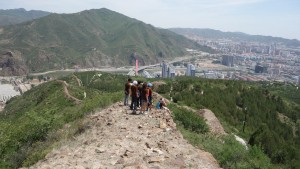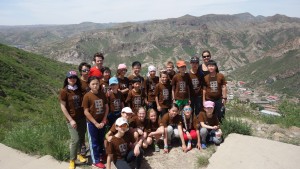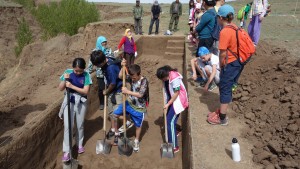The Hutong recently completed its first ever school program to the wilds beyond the Great Wall near China’s Winter Olympic hopeful city of Zhangjiakou. Adventurers from the International Montessori School of Beijing joined this program, breaking new ground in the grasslands near the remains of Hebei’s Anguli Lake basin. Although the journey was only three days in total, The Hutong was sure to pack the schedule full of hands-on activities, experiential learning activities, and even a few pleasant surprises. On the first day of the journey, rather than making the drive all the way to the final destination of
On the first day of the journey, rather than making the drive all the way to the final
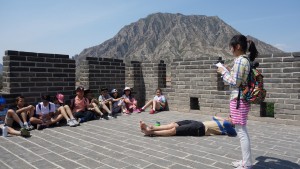
Exploring Jimingyi, a quiet village with an important history as a key stop for government messengers in imperial times.
destination of Anguli Lake, MSB students and teachers made a pit stop to explore one of the oldest postal station towns still standing in China, Jimingyi 鸡鸣驿。With a history dating back to the late Yuan Dynasty, the group was greeted by a site rarely seen in China, but common back during dynastic days: a complete city wall with entrance gates. After a entering the sleepy town, the group dined in a small restaurant specializing in “cola chicken wings.” Mr. Yang, the owner informed the students that he had moved away from Beijing five years earlier in order to enjoy the relative peace, quiet, and good air of Jimingyi. Once bellies were filled with local delicacies, students split into four groups to complete a letter-writing activity told from four different historical perspectives: a lonely princess, a foreign spy, the Empress Dowager Cixi, and a general on the wall. Students were essentially re-creating possible historical scenarios for letters that may or may not have passed through
Once bellies were filled with local delicacies, students split into four groups to complete a letter-writing activity told from four different historical perspectives: a lonely princess, a foreign spy, the Empress Dowager Cixi, and a general on the wall. Students were essentially re-creating possible historical scenarios for letters that may or may not have passed through Jimingyi when it was still used by the imperial postal service. Afterwards, we walked up on the wall where each group chose one member to share the letter. As we walked along the ramparts of the wall, students had to choose slips of paper from an envelope that explained their “postal party” members fates. Would their letters make it to the capital? Some messengers were bitten by poisonous snakes, others eaten by wolves, others fled with lovers. In the end Mr. Yang was at the final stop to greet us and collect all the letters, all of which made it to the final destination. Upon leaving the postal station, the group continued to the final destination,
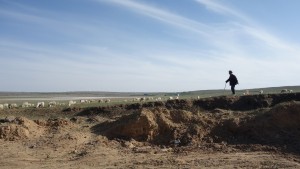 Upon leaving the postal station, the group continued to the final destination, Anguli Lake. Arriving in the late afternoon, students were greeted by flocks of sheep and herds of cattle returning home from a full day of grazing in the sprouts of grass from recent rainstorms. The owner of the yurt camp, Mr. Wu, welcomed students in traditional Mongolian garb, placing ceremonial hadas around each participant’s neck. After a Mongolian themed dinner, Mr. Wu’s son, a rough and tumble proud Mongolian named Mandakh, helped to prepare what would be the first bonfire of the three-day adventure. Khans from the student group entertained everyone with amusing stories. Locals who worked as tree planters in the area gathered around the fire to interact with the strange new visitors. The bonfire roused the wolf’s appetite, and students barbecued lamb skewers over the fire. Day two began with a breakfast including fresh milk squeezed from the cows at 4am. Afterwards,
Upon leaving the postal station, the group continued to the final destination, Anguli Lake. Arriving in the late afternoon, students were greeted by flocks of sheep and herds of cattle returning home from a full day of grazing in the sprouts of grass from recent rainstorms. The owner of the yurt camp, Mr. Wu, welcomed students in traditional Mongolian garb, placing ceremonial hadas around each participant’s neck. After a Mongolian themed dinner, Mr. Wu’s son, a rough and tumble proud Mongolian named Mandakh, helped to prepare what would be the first bonfire of the three-day adventure. Khans from the student group entertained everyone with amusing stories. Locals who worked as tree planters in the area gathered around the fire to interact with the strange new visitors. The bonfire roused the wolf’s appetite, and students barbecued lamb skewers over the fire. Day two began with a breakfast including fresh milk squeezed from the cows at 4am. Afterwards,
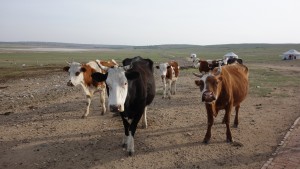 Day two began with a breakfast including fresh milk squeezed from the cows at 4am. Afterwards, Mandakh mentioned that there was an opportunity for the students to walk to a nearby archaeological discovery. Besides Mr. Wu’s house lived another neighbor named Ge Ri Le. He had been working with archaeologists in the area, and in 2014 they had discovered stone tools and relics dating back to Neolithic man. Along with Mandakh, the students walked for half an hour to the dig site where local farmers had been employed with shovels to dig away the top few meters of soil. Students were welcomed to jump in and give a hand putting their backs and muscles into true archaeological work! Afterwards, Mandakh led the group to the small lake called “Four Platforms,” also recently dried up. Walking in front of the group, Mandakh made sure to keep the students at a safe distance so that no one would walk into quicksand. It was at this time that MSB teachers were able to use their science expertise to have students examine the soil below their feet, something they are unable to do so often in Beijing. The group took a break from the grasslands and drove into the nearby town of Zhangbei for lunch. Immediately following lunch, MSB students would have yet another rare opportunity to visit an ancient archaeological site, the legendary “Yuan Zhongdu.” Still being excavated, Yuan Zhongdu is one of the 4 ancient capitals of the Mongolian Empire, the other three being Karakorum, Xanadu, and now modern day Beijing. They would not be visiting Yuan Zhongdu capital alone, however; selected students from a nearby primary school joined MSB for a school exchange within the walls of the ancient ruins! Divided into four groups, MSB students mixed with local students to take part in a performance activity in which they told the story of the emperor who ruled this capital, as well as the story of the capital itself. Local students and MSB literally made the ruins come to life underneath the beating hot sun. After taking time to perform and tell the story of the hallowed grounds, participants freely explored the ruins.
Day two began with a breakfast including fresh milk squeezed from the cows at 4am. Afterwards, Mandakh mentioned that there was an opportunity for the students to walk to a nearby archaeological discovery. Besides Mr. Wu’s house lived another neighbor named Ge Ri Le. He had been working with archaeologists in the area, and in 2014 they had discovered stone tools and relics dating back to Neolithic man. Along with Mandakh, the students walked for half an hour to the dig site where local farmers had been employed with shovels to dig away the top few meters of soil. Students were welcomed to jump in and give a hand putting their backs and muscles into true archaeological work! Afterwards, Mandakh led the group to the small lake called “Four Platforms,” also recently dried up. Walking in front of the group, Mandakh made sure to keep the students at a safe distance so that no one would walk into quicksand. It was at this time that MSB teachers were able to use their science expertise to have students examine the soil below their feet, something they are unable to do so often in Beijing. The group took a break from the grasslands and drove into the nearby town of Zhangbei for lunch. Immediately following lunch, MSB students would have yet another rare opportunity to visit an ancient archaeological site, the legendary “Yuan Zhongdu.” Still being excavated, Yuan Zhongdu is one of the 4 ancient capitals of the Mongolian Empire, the other three being Karakorum, Xanadu, and now modern day Beijing. They would not be visiting Yuan Zhongdu capital alone, however; selected students from a nearby primary school joined MSB for a school exchange within the walls of the ancient ruins! Divided into four groups, MSB students mixed with local students to take part in a performance activity in which they told the story of the emperor who ruled this capital, as well as the story of the capital itself. Local students and MSB literally made the ruins come to life underneath the beating hot sun. After taking time to perform and tell the story of the hallowed grounds, participants freely explored the ruins.
Immediately following lunch, MSB students would have yet another rare opportunity to visit an ancient archaeological site, the legendary “Yuan Zhongdu.” Still being excavated, Yuan Zhongdu is one of the 4 ancient capitals of the Mongolian Empire, the other three being Karakorum, Xanadu, and now modern day Beijing. They would not be visiting Yuan Zhongdu capital alone, however; selected students from a nearby primary school joined MSB for a school exchange within the walls of the ancient ruins! Divided into four groups, MSB students mixed with local students to take part in a performance activity in which they told the story of the emperor who ruled this capital, as well as the story of the capital itself. Local students and MSB literally made the ruins come to life underneath the beating hot sun. After taking time to perform and tell the story of the hallowed grounds, participants freely explored the ruins.
The group took a break from the grasslands and drove into the nearby town of Zhangbei for lunch. Immediately following lunch, MSB students would have yet another rare opportunity to visit an ancient archaeological site, the legendary “Yuan Zhongdu.” Still being excavated, Yuan Zhongdu is one of the 4 ancient capitals of the Mongolian Empire, the other three being Karakorum, Xanadu, and now modern day Beijing. They would not be visiting Yuan Zhongdu capital alone, however; selected students from a nearby primary school joined MSB for a school exchange within the walls of the ancient ruins!
Divided into four groups, MSB students mixed with local students to take part in a performance activity in which they told the story of the emperor who ruled this capital, as well as the story of the capital itself. Local students and MSB literally made the ruins come to life underneath the beating hot sun. After taking time to perform and tell the story of the hallowed grounds, participants freely explored the ruins. Once MSB made their farewells to their new local friends, the group returned to their Anguli grassland homes.
 The rest of the afternoon was filled with the twang of arrows as students practiced archery, as well as the squish of dumpling fillings between fingers. Rotating between the two activities, the group literally kept creating dumplings and practicing archery until the cows came home. The evening would have the students squishing cow patties in their fingers as they collected fuel for another bonfire. This time, they would infuse Western culture as smores took the place of roasted lamb skewers. In the evening, just before bedtime they put on their scientists hats one more time, digging traps made of milk cartons for local insects and prairie dogs. These would of course be released into the wild the following morning.
The rest of the afternoon was filled with the twang of arrows as students practiced archery, as well as the squish of dumpling fillings between fingers. Rotating between the two activities, the group literally kept creating dumplings and practicing archery until the cows came home. The evening would have the students squishing cow patties in their fingers as they collected fuel for another bonfire. This time, they would infuse Western culture as smores took the place of roasted lamb skewers. In the evening, just before bedtime they put on their scientists hats one more time, digging traps made of milk cartons for local insects and prairie dogs. These would of course be released into the wild the following morning.
After a final morning stretch and qigong session, MSB mounted their four-wheeled chariot to head to the Dajingmen section of the Great Wall. Completing a short but grueling hike along the Hebei-brown section, students once again found themselves side by side with history as they scaled the most battle-worn portion of the Wall. This was the area where Genghis Khan had humiliated the Jin Army centuries before. This was the area where the Kangxi Emperor had crossed after successful military campaigns to the West. This was the area where MSB would overcome their final physical challenge of the journey to overlook the sprawling city of Zhangjiakou to the South, and the wilds of Hebei to the North. With barbarians’ hearts and explorers mentalities, MSB continued back to the capital for one final leg of the journey.

